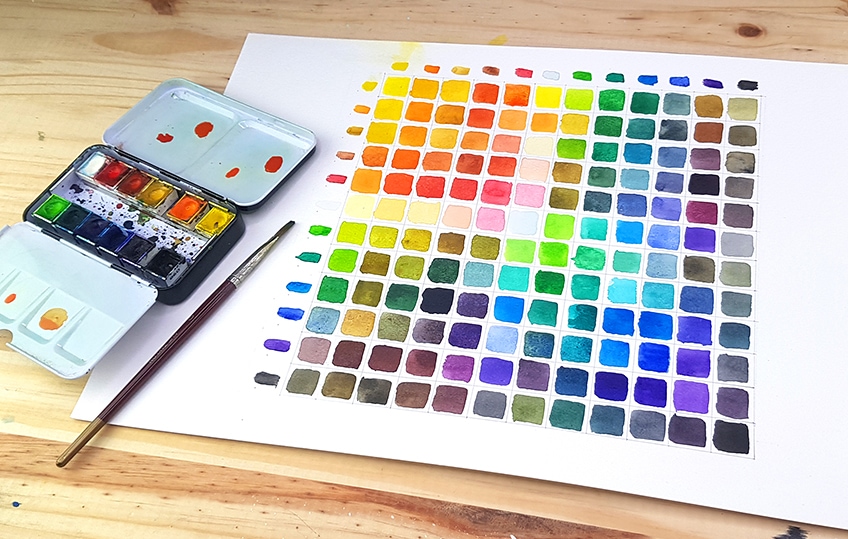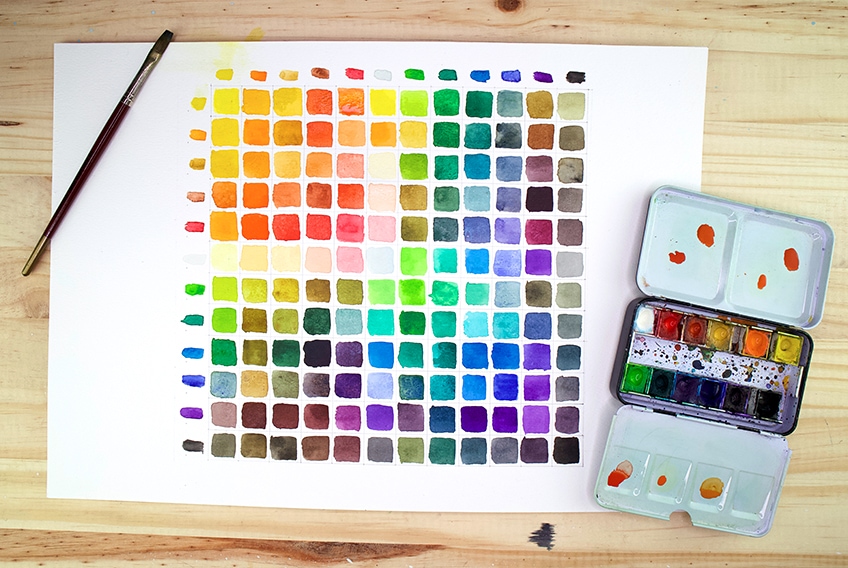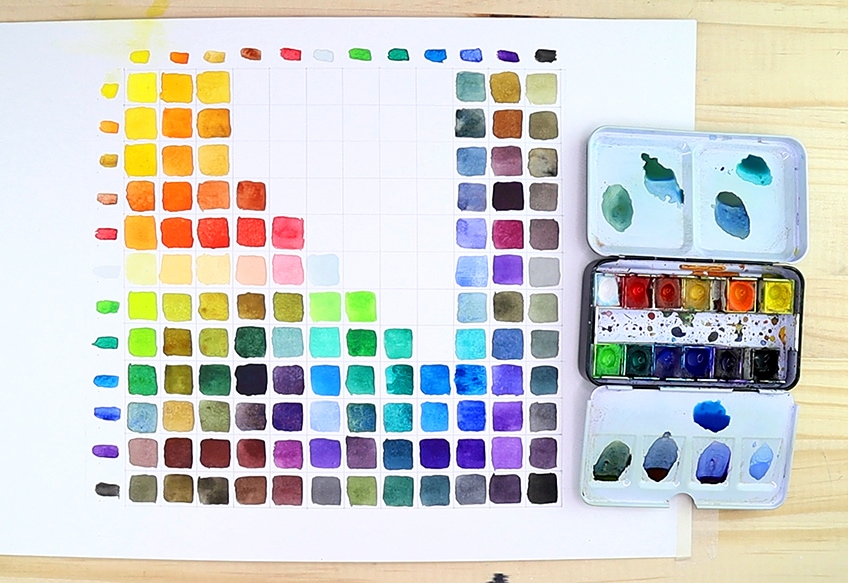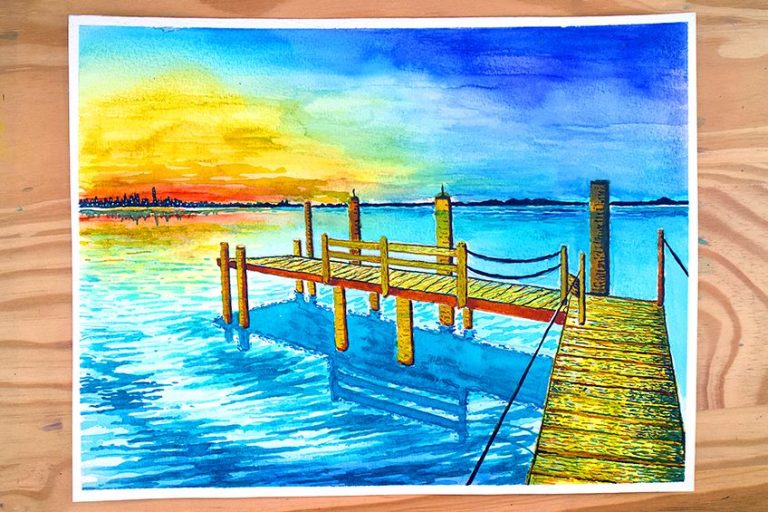How to Mix Watercolors – All You Need to Know About Watercolor Mixing
When you start learning how to mix watercolors, it may seem like a daunting task. The truth is that this wonderful and vibrant medium is actually easy to master! Not only is it easy and fun, but once you have learned how to use watercolor paint, you will find it to be a very relaxing and rewarding artform. In order to achieve the colors you desire for your watercolor art, you will need to practice watercolor mixing. There are many watercolor mixing recipes available to help you create any color you can think of. Therefore, there is no need to buy every single paint color when you know the ins and outs of watercolor mixing. Our tutorial will properly explain how to use watercolor paint in order to create a watercolor mixing palette with a limited color set. Let us get started!
Table of Contents
A Simple Guide to Watercolor Mixing
Watercolor mixing is easy when you understand the various watercolor mixing recipes. You will be able to mix up almost any color under the sun by using your very limited paint selection. When you look at the watercolor blue, red, or any other color, there are variations to that shade that can be made using a simple watercolor mixing palette. There are many colors that are not usually inside a watercolor paint set that you can mix up yourself. If you are wondering how to make gray watercolor or other less-available colors, then this tutorial is for you! Making a color chart will allow you to make up your desired watercolor mixing palette using very few and limited watercolors. Keep reading to learn exactly what you will need to get started!

Materials Needed
As you learn the art of watercolor mixing, you will be thankful for good-quality paper. Proper paper is what will ensure your watercolor mixing palette colors are absorbed correctly. You will want to buy paper that is at least 300 GSM in thickness as this will aid in proper paint absorption, ensuring a beautiful and vibrant true color display. Paper is not the only important tool you will need when learning how to mix watercolors. You will also need good quality, preferably natural bristle, watercolor brushes.
If you can afford a set of brushes that should be your first choice. For the purpose of our watercolor mixing palette, you will be using a flat brush.
Of course, paint is important too. If you are able to, purchase a good quality set of watercolor pan colors. You will also need some masking tape to keep your page from shifting and to help with warping, as well as a few jars of water to clean your brush. We have below a list of all the materials you will need and links to our favorite products should you wish to purchase online.
Creating a Watercolor Color Chart From Scratch
There are various watercolor mixing recipes and methods to help you on your watercolor mixing journey. Using these methods of color combining will help you understand how to use watercolor paint and make up colors that are not usually within your paint pan. If you want to make gray watercolor or variations of watercolor blue, your watercolor color chart is the first place to start. This tutorial will show you how to make a watercolor color chart showing all the beautiful colors you can create with your simple paint options.

This chart is invaluable when learning about watercolor mixing as it will help you to understand the variations of color. As you will see further on in the tutorial, you are going to create a chart or grid which will display all the colors along a horizontal axis and also down a vertical axis. Each color block you create will be 2 cm x 2 cm. Your blocks of color will move along both the horizontal and vertical axis. Each block will contain a different color combination and form part of a large color grid. The colors used in the various blocks are determined by the intersecting colors from the vertical and horizontal axis.
If you are ready and have all your materials, let us get started with our watercolor mixing!
Step 1: Preparation
Our easy-to-follow watercolor mixing tutorial is nothing to fear. You will soon see how easy the process is. As you learn how to mix watercolors using our simple watercolor mixing recipes you will quickly discover the secrets of a good watercolor mixing palette. Each color you create will use different ratios and require some experimentation. As you learn more about how to mix watercolors you should relax and take as much time as you need. Remember, playing around with watercolor mixing recipes and learning how to use watercolor paint is a fun and peaceful process, do not rush! Put on some of your favorite music and have a good time!

Step 2: Grid Making
Most of the time, a watercolor paint pan will contain 12 colors, so our tutorial will be based on this. This means that your grid should have 12 vertical columns as well as 12 horizontal columns. You will have a total of 144 blocks to place your colors within. Using your pencil and ruler, measure along both the horizontal and vertical axis and make a mark every 2 cm. Essentially, you will have a 24 cm x 24 cm square drawn on your page with 2 cm x 2 cm blocks within it.

Step 3: Making a Vertical and Horizontal Axis With Colors
The next step, before painting, is to secure your page down with masking tape. Once you have secured the page to your surface it is time to grab your brushes and paint. Do not forget a couple of mason jars filled with water so that you are able to clean your brush after every use. In front of the first row of the horizontal axis, apply each color in its respective block. You will now repeat this process for the vertical axis.

Make sure that the colors are applied in the same sequence for both axes. If you are confused, the image below should clear that up. Your painted sections do not have to be perfect in any way, however, if you are a bit of a perfectionist, feel free to make little circles or smaller squares. Before you apply a new color, make sure you have cleaned your brush properly.
Step 4: Dividing the Grid With Colors
We will now paint the blocks of our watercolor grid. Start with the corner on the top left-hand side of the page, again corresponding with the colors in the horizontal and vertical axes. This time you will be moving diagonally towards the bottom right-hand corner. You should see a diagonal line of bright colorful blocks by the time you are done. If you are still a little confused, take a quick look at the image to clarify. Basically, you want the yellow block to meet the yellow on the vertical axis, as well as the yellow on the horizontal axis. The same applies to all the colors.

You will now notice that your watercolor grid has been split into two sections on your page. When painting your blocks, do not be too worried about creating perfect squares of color, and try to leave a small section of negative space around your paint colors. This is so your colors do not overlap later on. As always, make sure you are using a clean brush with every application of new paint.
Step 5: Filling in the Color Blocks
The second last step involves creating color combinations to fill the rest of the blocks on either side of our initial diagonal line. In order to select the correct colors, all that you need to do is match the color sequence of both the vertical and horizontal axis. Locate where the colors interact on your page and mix those two colors together. Then, apply that mixture to the block. Easy!

You might be wondering why we mentioned dividing the page in step three. Well, you may have noticed that every color is going to intersect on your grid twice. Instead of applying the exact same combination of color to both blocks, you should rather experiment with color ratios, apply a little more of one color in the first block and less of the same color in the second. Remember, do not mix up your watercolor paints on the page itself. A porcelain plate makes for an excellent surface to mix on. We cannot stress enough the importance of cleaning your brush before loading it with a new color, you do not want any of the wrong paint getting into your mixes.

It is also a good idea to work one column at a time. This will enable you to completely focus on a specific color. For example, all the shades and variety of watercolor blue. You can completely tune out any outside distraction and learn how each color interacts with another in your paint mixing. You might be tempted to just mix in the lid of your watercolor paint pan, but this is not advised. Usually, this space is quite small and the risk of colors mixing unintentionally is larger. As mentioned before, a large dinner plate is a good surface for your watercolor mixing recipes to unfold.
Pay attention while you are mixing so that you are able to watch and understand how the various colors interact with one another.
The best way to learn is to experiment with your ratios and watercolor paints. When you use different ratios, you will be able to create lighter and darker shades of a specific color. Once the lower half of your grid is complete, you can complete the upper right-hand half.
Step 6: Completing the Grid
We are almost done with our tutorial! It is time to complete the remaining part of the watercolor grid. Do not fret about which order you are placing the colors, as long as there are variations in different hues and shades which are created by using the colors that intersect along the grid.
Remember, if you apply your paint column by column, mixing will be a lot easier as you will just be adding to the already mixed paint on your plate. It is also advised to do the darker colors and black last. Of course, this is purely a suggestion. Feel free to do as you wish, there are no hard or fast rules!

As the top right-hand half of your grid begins to fill up with colors, you will see that just like before, colors intersect twice. Try to change up your ratios within your watercolor mixing recipes so that no two colors are exactly the same. If the watercolor blue in the first block is a light shade, paint your second block in a darker blue shade, and so on.
When it comes to how to make gray watercolor paint, you will need a specific recipe. This recipe is a combination of mostly black paint with a little bit of white, or the other way around if you prefer a lighter shade of gray. As with gray, you can apply this same method to all colors you mix.

Another thing to think about is mixing from light to dark. For example, if you are doing yellow, slowly add more red to make various shades of yellow and orange. It is always smart to first clean your brush before dabbing it into another color. This is because you do not want other colors mixing into your paint pan, especially darker colors into light ones! Keep your brushes clean as you work to avoid any mistakes
Last but not least, relax and take as much time as you need when experimenting with watercolor mixing recipes as you create your grid. The skill of watercolor mixing takes time to learn and perfect so do not rush the process. We know that coloring in 144 small blocks can seem daunting and a little tedious. Luckily, this tutorial allows you to set your project aside and complete it later whenever you want to!
Handy Hints and Tips for Watercolor Mixing
Every medium has its own set of handy hints and tips to help make your experience better. None of these are rules and you can do as you please, but they are incredibly helpful! While you practice and learn the art of watercolor mixing, these helpful hints will make the experience easier.
- While you paint, always have two glasses or jars of water available for easy brush cleaning while you work and also to prevent your paints from other colors.
- Remember to replace the dirty water every so often.
- As you mix your colors, you may grow tired. This project allows for easy pick up the following day.

- Your ratios can be altered and tweaked. We encourage you to play around and experiment with the paints and combinations.
- As you work, keep cleaning your brush.
- Have fun and relax! Painting is not meant to be a stressful endeavor.
This tutorial will have taught you the basics of how to mix watercolors. As your confidence grows and you learn your ratios, everything will become second nature to you! While you learn you can play around with the ratios and find the shades you like the most. This grid is your playground and you can have complete fun and control while creating your blocks of watercolor paint variations. Creating this grid is intended to teach you about the colors, how the paints work, and how they integrate when mixed with other colors. The biggest thing to remember is to have fun and not to take anything too seriously. We hope you enjoy this beautiful medium as you learn to create with watercolors!
Frequently Asked Questions
Why Does One Need a Watercolor Mixing Chart?
Before you jump into the world of watercolor painting, you should first learn how to mix watercolors and about watercolor mixing recipes. Learning about color ratio and how to use watercolor paint correctly will help establish a good foundation for when you start creating art. This will make painting with watercolor more enjoyable as well as help you to completely understand how the paints work, especially with one another. A color grid is a perfect tool to help you truly maximize your skill before learning about watercolor techniques and methods.
How to Mix Watercolors That Are Popular?
As you learn and gather more information about how to paint with watercolors, you will notice that there are colors that are deemed to be more popular than others. These colors can be used to mix up ratios creating color combinations like no others! Some of these include shades of watercolor blue, burnt sienna, or even ultramarine. If you want to learn how to make gray watercolor tones or any other interesting combination of colors, you can learn how by making a grid or color chart. You will be able to create an entire and full-color spectrum after understanding how to mix the paints correctly, using just a few popular colors!
Will I Need Specific Colors to Create and Mix Watercolor Paint?
Yes and no. The primary colors are the most important color paints you will require in order to create any color you can imagine. That said, if you do not have all the primary colors, you will still be able to mix many tones, hues, and shades using just the colors available to you at the time. Of course, the more colors you have, the more diverse your watercolor mixing palette will be. Colors like white and black are useful too, especially to help lighten and darken shades. Watercolor mixing recipes are entirely dependent on your own tastes or desires and can be experimented with to a large degree. We should always remember the color wheel while we mix, but still, have fun with what we are doing because that is the only way to learn and create.
Matthew Matthysen is an educated multidisciplinary artist and illustrator. He successfully completed his art degree at the University of Witwatersrand in South Africa, majoring in art history and contemporary drawing. The focus of his thesis was to explore the philosophical implications of the macro and micro-universe on the human experience. Matthew uses diverse media, such as written and hands-on components, to explore various approaches that are on the border between philosophy and science.
Matthew organized various exhibitions before and during his years as a student and is still passionate about doing so today. He currently works as a freelance artist and writer in various fields. He also has a permanent position at a renowned online gallery (ArtGazette) where he produces various works on commission. As a freelance artist, he creates several series and successfully sells them to galleries and collectors. He loves to use his work and skills in various fields of interest.
Matthew has been creating drawing and painting tutorials since the relaunch in 2020. Through his involvement with artincontext.org, he has been able to deepen his knowledge of various painting mediums. For example, watercolor techniques, calligraphy and lately digital drawing, which is becoming more and more popular.
Learn more about Matthew Matthysen and the Art in Context Team.
Cite this Article
Matthew, Matthysen, “How to Mix Watercolors – All You Need to Know About Watercolor Mixing.” Art in Context. April 13, 2022. URL: https://artincontext.org/how-to-mix-watercolors/
Matthysen, M. (2022, 13 April). How to Mix Watercolors – All You Need to Know About Watercolor Mixing. Art in Context. https://artincontext.org/how-to-mix-watercolors/
Matthysen, Matthew. “How to Mix Watercolors – All You Need to Know About Watercolor Mixing.” Art in Context, April 13, 2022. https://artincontext.org/how-to-mix-watercolors/.









